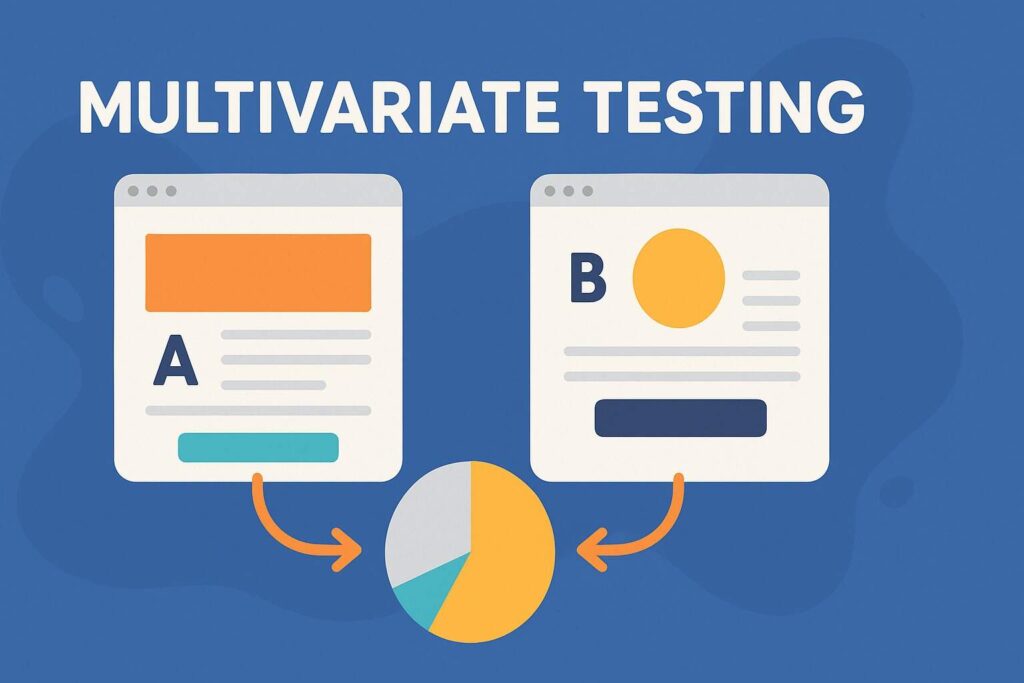Table of Contents
face it—sometimes digital marketing feels like throwing spaghetti at the wall and hoping something sticks. You try a new headline here, a brighter button there, maybe switch out an image… and then cross your fingers.
But what if you didn’t have to guess?
What if there was a way to test multiple ideas at the same time—and know which combination actually works best?
That’s exactly what multivariate testing helps you do. And trust me, once you understand how it works, you’ll never go back to making changes blindly.
So… What Is Multivariate Testing, Really?
In simple terms, multivariate testing is like a smarter version of A/B testing.
You’re not just testing two headlines or two button colors—you’re testing different versions of multiple elements on a page all at once. And then, you let the data tell you which combo performs best.
Let’s say you have:
- Two headlines
- Two images
- Two button texts
That’s 2 x 2 x 2 = 8 total combinations of your page.
Multivariate testing lets you test those 8 versions and figure out which mix of headline, image, and button actually gets the most clicks, signups, or sales.
It’s like running a little science experiment with your webpage—and letting your visitors show you what works.
Why Multivariate Testing Is Worth It
You might be thinking, “Can’t I just change one thing at a time and see how it goes?”
Sure, that’s what A/B testing is for. And it works—to a point.
But here’s the thing: real people don’t experience your website one element at a time. They take it in as a whole. The headline, the image, the call-to-action—all of it works together to create a feeling or inspire an action.
So while A/B testing might tell you which headline is better, it won’t tell you which headline works best with a specific button and image.
That’s where multivariate testing shines. It doesn’t just test elements—it tests combinations.
A Simple Example (No Fancy Terms Needed)
Let’s say you run a fitness website and want more people to sign up for your free trial.
You decide to test:
- Two headlines:
“Get Fit at Home” vs “Train Smarter, Not Harder” - Two CTA buttons:
“Start Your Free Trial” vs “Join Now” - Two images:
A yoga pose vs a personal trainer coaching
Using multivariate testing, you create eight different versions of the same landing page.
You run the test and discover that the combo of “Train Smarter, Not Harder” + “Start Your Free Trial” + the yoga image gets 42% more sign-ups than the rest.
Would you have guessed that combo? Maybe not. But the numbers don’t lie—and now you have clarity.
What You Can Test
The best part about multivariate testing? You can apply it to nearly any part of your site or campaign. Here are just a few ideas:
- Headlines
- Images or graphics
- Call-to-action buttons (color, text, size)
- Backgrounds
- Product descriptions
- Layout or format
- Navigation bar options
Just remember: don’t go overboard. Testing too many things at once can overwhelm the system (and your audience). Start small. Pick 2 or 3 important elements and go from there.
How to Run a Multivariate Test (Without Losing Your Mind)
You don’t need a tech degree or a huge team to run a multivariate test. Here’s how to keep it simple:
1. Set a Clear Goal
What are you trying to improve? Clicks? Sign-ups? Purchases? Be specific.
2. Choose What to Test
Pick 2 or 3 key things you think could impact your goal—like a headline, image, and button.
3. Create Your Variations
Come up with two versions of each element. Keep it realistic—don’t design pages that feel totally disconnected from your brand.
4. Use a Tool
You don’t have to do this manually. Tools like Optimizely, VWO, and Convert make it easy to set up and run multivariate tests.
5. Let the Test Run
Give your test time to collect meaningful data. A few days isn’t always enough—especially if your traffic is low.
6. Pick the Winning Combo
Once you’ve got enough data, choose the combination that performed best. Then go live with it!
Pro Tips (From Someone Who’s Been There)
- Start small – 2–3 variables is more than enough for your first test.
- Use pages that get traffic – Otherwise, it’ll take forever to get useful results.
- Stick to one goal per test – You’ll get clearer insights.
- Don’t run multiple tests on the same page at once – That can mess with your results.
Mistakes to Avoid (Trust Me, I’ve Made Them)
Multivariate testing can be super helpful, but only if you do it right. Here are some common mistakes to avoid:
- Testing too many things at once – You’ll need massive traffic to make sense of the results.
- Quitting the test too early – Let it run long enough to collect real data.
- Picking random things to test – Focus on elements that influence decisions.
- Ignoring your mobile audience – Mobile users behave differently; keep that in mind.
Should You Try Multivariate Testing?
If you want better results from your website or marketing campaigns, then yes—multivariate testing is worth exploring.
It’s one of the most effective ways to:
- Stop guessing and start understanding
- Improve what’s already working
- Optimize your design and messaging based on real user behavior
And the best part? Once you start using it, you build a habit of learning from your audience—rather than just hoping you got things right.
Final Thought
In a world full of opinions, multivariate testing gives you clarity.
You’ll know what works, why it works, and how to keep improving. And you don’t need a massive team, budget, or fancy setup to get started.
Just curiosity, a few smart ideas, and the willingness to test.
Ready to find the perfect mix? Start small, test thoughtfully, and let your audience show you the way.

